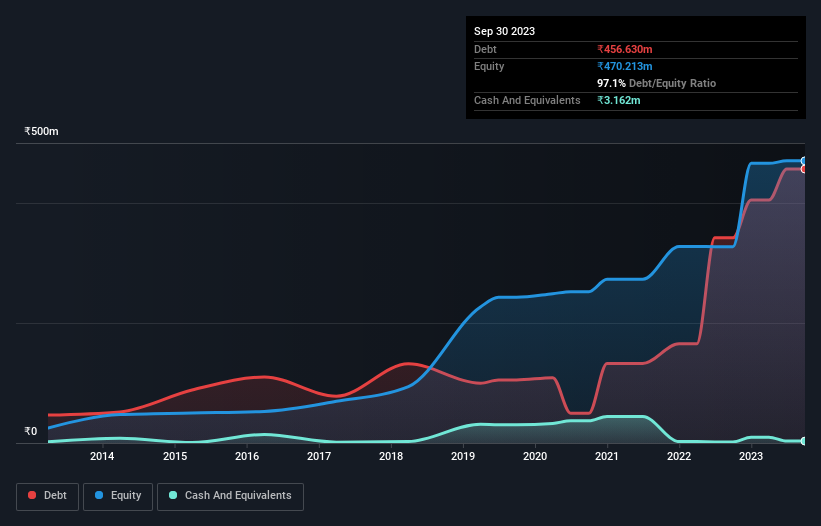
Legendary fund manager Li Lu (who Charlie Munger backed) once said, 'The biggest investment risk is not the volatility of prices, but whether you will suffer a permanent loss of capital.' It's only natural to consider a company's balance sheet when you examine how risky it is, since debt is often involved when a business collapses. As with many other companies Ushanti Colour Chem Limited (NSE:UCL) makes use of debt. But is this debt a concern to shareholders?
When Is Debt Dangerous?
Generally speaking, debt only becomes a real problem when a company can't easily pay it off, either by raising capital or with its own cash flow. Ultimately, if the company can't fulfill its legal obligations to repay debt, shareholders could walk away with nothing. However, a more frequent (but still costly) occurrence is where a company must issue shares at bargain-basement prices, permanently diluting shareholders, just to shore up its balance sheet. Of course, the upside of debt is that it often represents cheap capital, especially when it replaces dilution in a company with the ability to reinvest at high rates of return. The first step when considering a company's debt levels is to consider its cash and debt together.
See our latest analysis for Ushanti Colour Chem
How Much Debt Does Ushanti Colour Chem Carry?
The image below, which you can click on for greater detail, shows that at September 2023 Ushanti Colour Chem had debt of ₹456.6m, up from ₹341.9m in one year. Net debt is about the same, since the it doesn't have much cash.

How Strong Is Ushanti Colour Chem's Balance Sheet?
We can see from the most recent balance sheet that Ushanti Colour Chem had liabilities of ₹340.6m falling due within a year, and liabilities of ₹271.5m due beyond that. Offsetting these obligations, it had cash of ₹3.16m as well as receivables valued at ₹266.5m due within 12 months. So its liabilities outweigh the sum of its cash and (near-term) receivables by ₹342.4m.
This is a mountain of leverage relative to its market capitalization of ₹566.6m. Should its lenders demand that it shore up the balance sheet, shareholders would likely face severe dilution. When analysing debt levels, the balance sheet is the obvious place to start. But you can't view debt in total isolation; since Ushanti Colour Chem will need earnings to service that debt. So if you're keen to discover more about its earnings, it might be worth checking out this graph of its long term earnings trend.
Over 12 months, Ushanti Colour Chem made a loss at the EBIT level, and saw its revenue drop to ₹377m, which is a fall of 30%. That makes us nervous, to say the least.
Caveat Emptor
While Ushanti Colour Chem's falling revenue is about as heartwarming as a wet blanket, arguably its earnings before interest and tax (EBIT) loss is even less appealing. To be specific the EBIT loss came in at ₹21m. Considering that alongside the liabilities mentioned above does not give us much confidence that company should be using so much debt. Quite frankly we think the balance sheet is far from match-fit, although it could be improved with time. Another cause for caution is that is bled ₹194m in negative free cash flow over the last twelve months. So in short it's a really risky stock. When analysing debt levels, the balance sheet is the obvious place to start. But ultimately, every company can contain risks that exist outside of the balance sheet. Be aware that Ushanti Colour Chem is showing 5 warning signs in our investment analysis , and 3 of those are a bit concerning...
If, after all that, you're more interested in a fast growing company with a rock-solid balance sheet, then check out our list of net cash growth stocks without delay.
New: AI Stock Screener & Alerts
Our new AI Stock Screener scans the market every day to uncover opportunities.
• Dividend Powerhouses (3%+ Yield)
• Undervalued Small Caps with Insider Buying
• High growth Tech and AI Companies
Or build your own from over 50 metrics.
Have feedback on this article? Concerned about the content? Get in touch with us directly. Alternatively, email editorial-team (at) simplywallst.com.
This article by Simply Wall St is general in nature. We provide commentary based on historical data and analyst forecasts only using an unbiased methodology and our articles are not intended to be financial advice. It does not constitute a recommendation to buy or sell any stock, and does not take account of your objectives, or your financial situation. We aim to bring you long-term focused analysis driven by fundamental data. Note that our analysis may not factor in the latest price-sensitive company announcements or qualitative material. Simply Wall St has no position in any stocks mentioned.
About NSEI:UCL
Ushanti Colour Chem
Manufactures and sells chemicals, dyes, and intermediates in India.
Slight and slightly overvalued.
Similar Companies
Market Insights
Community Narratives




